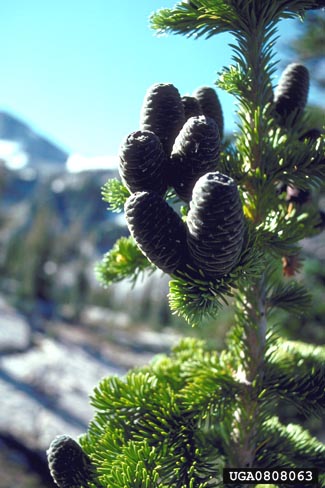Balsam Fir

Common Name(s):
Subalpine Fir
Balsam Fir
Scientific Name:
Abies lasiocarpa Nutt.
Scientific Name Synonyms:
None known
Symbol:
ABLA
Description:
Life Span: Perennial
Origin: Native
Season: Deciduous
Growth Characteristics: Subalpine fir has a very distinctive crown that is slender and spire-like. The upper several feet of the crown may have a diameter of less than 1 foot. The branches of this tree persist on the trunk right to the ground. This tree seldom exceeds 90 feet in height and 2 feet in diameter at maturity.
Flowers/Inflorescence: Cones are produced in abundance each year near the tops of the tree. Male cones are in small clusters on underside of twig ends. Female (seed) cones are about 3-½ inches long and dark purple when mature. They always grow on upper branches in an erect position on twigs. When these cones mature, the cone scales and seeds fall off leaving an erect woody spike-like cone axis on the twig. Subalpine fir cones mature in one growing season.
Fruits/Seeds: The seeds are about ¼ inch long with a single, broad, flat, terminal wing.
Leaves: Needle-like, and about 1 inch long. The tips of the leaves are blunt and the leaf itself is flattened and flexible. Even though the leaves arise from twigs on all sides (spirally arranged), they all tend to grow upward. Buds are about ¼ inch long and orange colored.
Stems: Twigs are usually smooth with small, inconspicuous leaf scars. Young growth twigs are covered with fine hairs. The bark is thin, smooth, and ash-gray colored on young trees. It becomes somewhat furrowed on older trunks. Small resin blisters are abundant on young to medium age trees. The wood is soft and rather brittle, usually light in color and very quick to decay.
Ecological Adaptions:
Subalpine fir is a middle to upper elevation mountain conifer. It generally occupies sites with a short growing season caused by cold winters, cool summers, frequent summer frosts, and heavy snowpack. It forms extensive forests between warm and dry lower elevation forests of Douglas-fir, white fir, lodgepole pine, or blue spruce, and higher elevation alpine tundra. At its lower elevational limits, subalpine fir is often restricted to streambottoms, ravines, frosty basins, or north exposures. It increasingly occupies westerly and easterly aspects with increasing elevation and may occupy all aspects at upper timberline. It is shade tolerant.
Soils: Moist
Associated Species: Douglas fir, Engelmann spruce, and blue spruce.
Uses and Management:
Subalpine fir has had only limited use in Utah. The wood is primarily used for products such as lumber for home construction and for prefabricated wood products. Subalpine fir has excellent pulping properties. Use for poles and pilings requires large amounts of preservatives because the wood decays rapidly. Small trees are extensively used for Christmas trees.
Subalpine-fir-dominated stands generally do not produce enough forage for livestock but do provide browse and cover for large and small wildlife species. Mule deer, elk, moose, woodland caribou, black bear, and grizzly bear often use subalpine fir habitats as summer range. Its seeds are eaten by several species of small mammals and birds.
Native Americans used various parts of subalpine fir for numerous purposes. A hair tonic was prepared by mixing powdered needles with deer grease. Finely ground needles were also sprinkled on open cuts. Sticky resin collected from the bark was boiled and used as an antiseptic for wounds or as a tea for colds. Boughs were placed in rooms for their aroma, and pulverized needles were used as a body scent or as perfume for clothing.
Resin from the bark is used in the optical industry and in laboratories as a cement for lenses and microscope slides.

